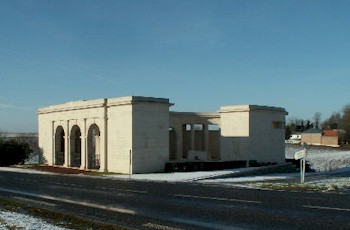|
|
| Home Topics Memorials Miscellany Transcripts References Family History Glossary Latest Beeston Blog About us | Site Search |
|
The following extract is taken from the Beeston Gazette & West Notts Echo of January 12th 1918 :
Harry Ward was wounded at Ypres on the 2nd November 1914 but was soon back in action. He was awarded the Military medal in August 1917 for leading his men in action after all the officers in the company were either wounded or killed. Before the war started, Harry Ward was employed at the Ericssons Works at Beeston. A single man, he was born in Radford in about 1892 and was educated at the Christ Church Schools there3. His mother, Helen Ward, later lived at Crocus Street in the Meadows, Nottingham. CambraI Memorial : The small village of Louverval is on the north side of the N30, Bapaume to Cambrai road, 13 kilometres north-east of Bapaume and 16 kilometres south-west of Cambrai. The Memorial stands on a terrace in Louverval Military Cemetery, which is situated on the north side of the N30, south of Louverval village. The CambraI Memorial commemorates more than 7,000 servicemen of the United Kingdom and South Africa who died in the Battle of Cambrai in November and December 1917 and whose graves are not known. Sir Douglas Haig described the object of the Cambrai operations as the gaining of a 'local success by a sudden attack at a point where the enemy did not expect it' and to some extent they succeeded. The proposed method of assault was new, with no preliminary artillery bombardment. Instead, tanks would be used to break through the German wire, with the infantry following under the cover of smoke barrages. The attack began early in the morning of 20 November 1917 and initial advances were remarkable. However, by 22 November, a halt was called for rest and reorganisation, allowing the Germans to reinforce. From 23 to 28 November, the fighting was concentrated almost entirely around Bourlon Wood and by 29 November, it was clear that the Germans were ready for a major counter attack. During the fierce fighting of the next five days, much of the ground gained in the initial days of the attack was lost. For the Allies, the results of the battle were ultimately disappointing but valuable lessons were learnt about new strategies and tactical approaches to fighting. The Germans had also discovered that their fixed lines of defence, no matter how well prepared, were vulnerable. The Cambrai Memorial was designed by H Chalton Bradshaw with sculpture by C S Jagger. The memorial stands on a terrace at one end of Louverval Military Cemetery. The chateau at Louverval, was taken by the 56th Australian Infantry Battalion at dawn on 2 April 1917. The hamlet stayed in Allied hands until the 51st (Highland) Division was driven from it on 21 March 1918 during the great German advance, and it was retaken in the following September. Parts of Rows B and C of the cemetery were made between April and December 1917 and in 1927, graves were brought in from Louverval Chateau Cemetery, which had been begun by German troops in March 1918 and used by Commonwealth forces in September and October 1918. The cemetery now contains 124 First World War burials.4 Footnotes 1His rank is given as Lance Sergeant on the Commonwealth War Graves Commission website and in "Soldiers Died in the Great War". 2Although living at home at the time of the 1911 census, Harry is recorded then as a Private soldier with the 1st Battalion, the Grenadier Guards. (1911 Census - Piece 1231 RD430 SD4 ED23 Schedule 341) 3Harry was the third child of eight children of William and Ellen Ward (née Heath). William was an engine fitter and the family lived on Denman Street, Radford, with his widowed mother, Ann, for all of their married life.(see 1891 Census - Piece 2685 Folio 11 and 1901 Census - Piece 3181 Folio 21). In 1908, William died, aged 45, and his mother Ann died in the following year. Ellen, then a 48 year-old widow can be found in the 1911 Census (Piece 1231 RD430 SD4 ED23 Schedule 341) living with six of her children, including Harry (then aged 19) on Greek Street, Nottingham. 4The desciption of the Cambrai Memorial is based on that on the Commonwealth War Graves Commission website. (http://www.cwgc.org) |
|
|||||||||||
|
|
|||||||||||||
